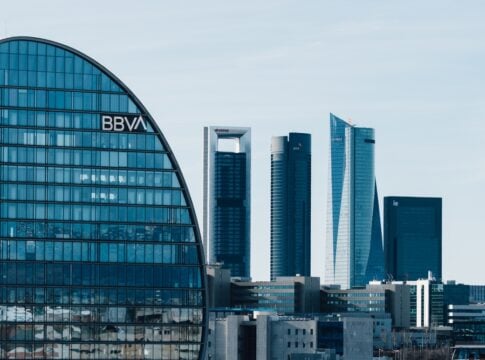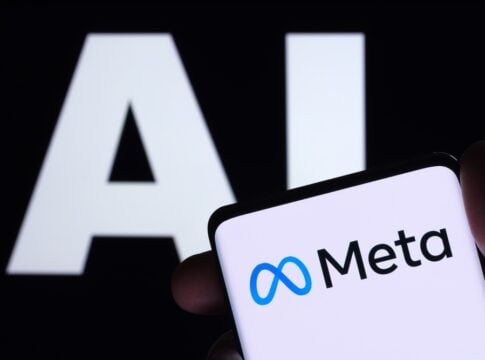Over the weekend the Washington Spectator published my essay, Diary of a Transit Miracle, recounting the arduous march of NYC congestion pricing from a gleam in a trio of prominent New Yorkers’ eyes, to the verge of startup at the stroke of midnight June 30, the startup time announced by the MTA last Friday.
 I’m cross-posting it here — the third post on the subject in this space in the past 12 months (following this in December and this post last June) — because the advent of congestion pricing in the U.S. is “a really big deal,” as a number of friends and colleagues have told me in recent weeks. As my new essay makes clear, charging motorists to drive into the heart of Manhattan isn’t just a rejection of unconstrained motordom, it’s a new beachhead in “externality pricing” — social-cost surcharging — of which carbon taxes are the ultimate form.
I’m cross-posting it here — the third post on the subject in this space in the past 12 months (following this in December and this post last June) — because the advent of congestion pricing in the U.S. is “a really big deal,” as a number of friends and colleagues have told me in recent weeks. As my new essay makes clear, charging motorists to drive into the heart of Manhattan isn’t just a rejection of unconstrained motordom, it’s a new beachhead in “externality pricing” — social-cost surcharging — of which carbon taxes are the ultimate form.
The essay features two governors, two mayors — one of whom I served a half-century ago as a lowly but admiring data cruncher — a civic “Walter Cronkite,” a Nobel economist, raucous transit activists, a gridlock guru and yours truly, plus a cameo appearance by Robert Moses. It includes footage of the historic 1969 press conference in which Mayor John Lindsay and two distinguished associates enunciated the core idea of using externality pricing to better balance automobiles and mass transit that animated the arduous but ultimately triumphant congestion pricing campaign.
— C.K., April 29, 2024
Diary of a Transit Miracle
A miracle is coming to New York City. Beginning on July 1, and barring a last-minute hitch, motorists will soon pay a hefty $15 to enter the southern half of Manhattan — the area bounded by the Hudson River, the East River and 60th Street.
An anticipated 15 percent or so of drivers will switch to transit, unsnarling roads within the “congestion zone” and routes leading to it. The other 80 or 90 percent will grumble but continue driving. That is by design. The toll bounty, a billion dollars a year, will finance subway enhancements like station elevators and digital signals that will increase train throughput and lure more car trips onto trains.
The result will be faster, smoother commutes, especially for car drivers and taxicab and Uber passengers, who will pay a modest surcharge of $1.25 to $2.50 per trip. Drivers of for-hire vehicles will benefit as well, as lesser gridlock leads to more fares.1
The miracle is three-fold: Winners will vastly outnumber losers; New York will be made healthier, calmer and more prosperous; and that this salutary measure is happening at all, after a half-century of setbacks.
Obstacles to congestion pricing
Congestion pricing, as the policy is known, faced formidable obstacles even beyond the difficulty inherent in asking a group of people to start forking over a billion dollars a year for something that’s always been free.
Congestion pricing also had to contend with: an ingrained pro-motoring ideology that casts any restraint on driving as a betrayal of the American Dream; a general aversion to social-cost surcharges (what economists call “externality pricing”); exasperation over the region’s balkanized and convoluted toll and transit regimes; and, of late, a decline in social solidarity and appeals to the common good.
The advent of congestion pricing in New York is, thus, cause not just for celebration but wonderment. How did this wonky yet radical idea advance to the verge of enactment?
Origins
The trail begins in the waning days of 1969, when newly re-elected mayor John Lindsay recruited two well-regarded New Yorkers to devise a plan to fend off a 50 percent rise in subway and bus fares.
William Vickrey, a Canadian transplant teaching at Columbia and a future Nobel economics laureate, was a protean theorist of externality pricing. New York-bred mediator Theodore Kheel was admired as a civic Walter Cronkite for his plain-spoken common sense.
Lindsay, too often dismissed as a lightweight, understood mass transit as key to loosening automobiles’ spreading chokehold over the city. He had made combating air pollution a pillar of his first term and was fast becoming an exemplar of urban environmentalism. From his municipal engineers, Lindsay knew that technology to clean up tailpipes still lay in the future. A transit fare hike that would add yet more vehicles to city streets imperiled his clean-air agenda.
The triumvirate proposed a suite of motorist fees to preserve the fare. Their program ― higher registration fees and gasoline taxes, a parking garage tax, doubled tolls ― though mild in today’s terms, threatened powerful bureaucracies and their auto allies. Newly dethroned “master-builder” Robert Moses opined that Kheel, in his zeal to save the fare, had “gone berserk over bridge and tunnel tolls.”2 The program went nowhere.
L to R: Kheel, Lindsay, Vickrey. Click arrow to view (please excuse two brief garbled passages toward end).
Moses was right to be alarmed. From a City Hall podium on Dec. 16, 1969, Mayor Lindsay showcased Kheel’s and Vickrey’s respective reports, “A Balanced System of Transportation is a Must” and “A Transit Fare Increase is Costly Revenue.” (Click link in still photo above to view 27-minute video.) The trio propounded a new urban doctrine rebalancing automobiles and public transportation: “Automobiles are strangling our cities… Starving mass transit imposes costs that are difficult to measure, yet real… Correcting the fiscal imbalance between transit and the automobile is key to enhancing our environment and quality of life…”
Their remarks set generations of urbanists on course toward congestion pricing.
Setbacks
Quantifying those precepts became my research agenda 40 years later. In the interim, two creditable attempts to enact congestion pricing crashed and burned.
The central element of Lindsay’s 1973 “transportation control plan” was tolls on the city’s East River bridges, a measure designed to eliminate enough traffic to satisfy federal clean-air standards. Though the plan’s formal demise didn’t come until 1977, in legislation written by liberal lawmakers from Brooklyn and Queens, the toll idea never stood a chance. Electronic tolling was 20 years away, and adding stop-and-go toll booths seemed more likely to compound vehicular exhaust than to cut it.
Three decades later, in 2007, Mayor Michael Bloomberg asked Albany to toll not just the same East River bridges but also the more-trafficked 60th Street “portal” to mid-Manhattan. Predictably, faux-populist legislators saw Bloomberg’s billionaire wealth as an invitation to denounce the congestion fee as an affront to the little guy.
The mayor may have hurt his cause by presenting congestion pricing primarily as a climate and pollution measure. The pollution rationale was no longer compelling in the way it had been in Lindsay’s day, as automotive engineers had slashed rates of toxic vehicle exhaust ten-fold. Appeals tied to global warming also fell flat; remember, congestion pricing contemplated that most drivers would stay in their fossil-fuel burning cars.
This isn’t to say that congestion pricing confers no climate benefits. Rather, the benefits are subtler ones that can be hard to convey to voters, such as making climate-friendly urban living more attractive. A further benefit may come as congestion pricing demonstrates the unique power of externality pricing, as explained below.
From the Rubble
Even as Bloomberg’s toll plan was faltering in Albany, new loci of support were germinating in the city.
Changing times demanded not just the intellectual leadership of think-tanks like the Regional Plan Association and the good-government Straphangers Campaign, but gritty, grassroots transit organizing. Enter the newly-minted Riders Alliance.

2017 subway handbill exemplified new militancy targeting Gov. Andrew Cuomo for failing transit.
As subway service began cratering in 2015, the inevitable result of budget-raiding by a skein of governors, the Alliance posted crowd-sourced photos of stalled trains and jammed platforms alongside demands for improved service from “#CuomosMTA.” Before long, the papers were pointing the finger at the governor not just in “Why Your Commute Is Bad” explainers but in tear-jerkers like the Times’ May 2017 classic, “Money Out of Your Pocket”: New Yorkers Tell of Subway Delay Woes.
The drumbeat was deafening. Cuomo finally blinked. On a Sunday in August 2017, he phoned the Times’ Albany bureau chief and handed him a scoop for the next day’s front page: Cuomo Calls Manhattan Traffic Plan an Idea ‘Whose Time Has Come’.
The “traffic plan” was congestion pricing.
Data Cruncher
Two months later, Cuomo’s staff summoned me to the midtown office of the consulting firm they had retained to “scope” congestion pricing ― essentially, to compute how much revenue tolls could generate. They wanted to see if an Excel spreadsheet model I had constructed and refined over the prior decade could aid their scoping process.
The model was called the Balanced Transportation Analyzer, a name bestowed in 2007 by Ted Kheel.
Ted, in his nineties, had recruited me to determine whether a large enough congestion toll could pay to make city transit free. The idea worked on paper but foundered politically. Nevertheless, Ted saw in my Excel modeling a way to capture phenomena like “rebound effects” (motorists driving more as road space frees up) and “mode switching” between cars, trains, buses and taxicabs, that he and Prof. Vickrey had identified in their 1969 work but lacked the computing ability to quantify.
Ted’s philanthropy enabled me over the next decade to expand, test and update my transportation modeling. With a hundred “tabs” and 160,000 equations, the “BTA” can instantly answer almost any conceivable question about New York congestion pricing, as well as these two central ones: how much revenue it will yield, and how much time will travelers save in lightened traffic and better transit.3
The BTA model aced its 2017 audition and became the computational engine for the congestion pricing legislation the governor’s team enacted into law in 2019. Its impact has been even broader.4 “Having the model helped make the case with the public, journalists, elected officials and others,” Eric McClure, director of the livable-streets advocacy group StreetsPAC, wrote recently, in part by helping congestion pricing proponents push back on opponents’ exaggerated claims of disastrous outcomes and their incessant demands for special treatment. The model may also have influenced the detailed toll design adopted by the MTA board earlier this year, which hewed close to the toll design I had recommended last summer.5
The BTA also provided sustenance during congestion pricing’s seven lean years ― the 2009-2016 period in which the torch was kept lit by a new triumvirate known as “Move NY” ― traffic guru “Gridlock” Sam Schwartz, the very able campaign strategist Alex Matthiessen, and myself. The model helped our team evangelize congestion pricing’s transformative benefits to elected officials and the public. This, I believe, was a key element in mustering the critical mass of support that ultimately swayed not one but two governors.
The Hochul Factor
New York Lieutenant Governor Kathy Hochul’s ascension to governor in August 2021 could have been congestion pricing’s death knell. The toll plan was adrift in the federal bureaucracy, and its latter-day champion Andrew Cuomo had exited in “me-too” disgrace. His successor, from distant Buffalo, wasn’t beholden to New York or congestion pricing.
Hochul, who as governor controls city and regional transit, could have disowned congestion pricing as convoluted, bureaucratic and tainted. Instead, she became a resolute and enthusiastic backer. Her spirited support, both in public and behind the scenes, became the decisive ingredient in shepherding congestion pricing to safety.
Why the new governor went all-in on congestion pricing awaits a future journalist or historian. Had she spurned it, the opprobrium from downstate transit advocates would have been intense; but there doubtless would have been cries of “good riddance” as well. Vickrey, Kheel and Riders Alliance notwithstanding, it’s not clear how closely New Yorkers — including transit users — connect congestion tolls to improved travel and a better city.
What makes Hochul’s embrace especially impressive is that congestion pricing is, in a real sense, an attack on a jealously guarded entitlement: the right to inconvenience others by usurping public space for one’s vehicle. The classic lament about entitlements’ iron grip is that “losers cry louder than winners sing.”6 Yet in this case, it seems, potential losers — actual and aspiring zone-bound drivers — are being out-sung by transit interests seeking, in Kheel’s 1969 words, a better balance between public transportation and automobiles.
Credits and Prospects
Let us now praise Andrew Cuomo’s crafting of the legislation that teed up congestion pricing’s successful run.
Rather than specifying a dollar price for the tolls, or a precise traffic reduction, his 2019 bill established a revenue target: sufficient earnings to bond $15 billion in transit investment — which equates to $1 billion a year to cover debt service. This device trained the public’s focus on the gain from congestion pricing (better transit) instead of the pain (the toll). Equally important, with this deft stroke, any toll exemption that a vocal minority might seek would mathematically trigger higher tolls for everyone else. The effect was vastly heightened scrutiny of requests for carve-outs.
Which cities will follow on New York’s heels? No U.S. urban area comes close to our trifecta of gridlock, transit and wealth. Sprawling Los Angeles or Houston, or even Chicago for that matter, might be better served by more granulated traffic tolls than New York’s all-or-none model.
Perhaps Asia’s megalopolises will be swept up in our wake. In the meantime, my focus will be on the holy grail of externality pricing: taxing carbon emissions. Every economist knows that the surest and fastest way to cut down on a “bad” is by taxing it rather than subsidizing possible alternatives. Yet that approach remains counter-intuitive and even anathema to nearly everyone else.
A huge and important legacy that New York congestion pricing could provide is to prove that intelligently taxing societal harms need not be electoral suicide. This proof could help unlock a treasure-trove of prosperity-enhancing pricing reforms including, most prominently, robust carbon taxing.
The author, a policy analyst based in New York City, worked in Mayor Lindsay’s Environmental Protection Administration in 1972-1974. He met Bill Vickrey in 1991 and worked closely with Ted Kheel from 2007 to 2010.
Endnotes
- The new passenger surcharges of $1.25 for taxicabs and $2.50 for “ride-hails” (principally Ubers) apply to trips touching the congestion zone. These will be partially offset by lower fares owing to shorter wait-time charges due to faster travel speeds.
- Quote is from Moses’ August 23, 1969 guest essay in Newsday, “Is Rubber to Pay for Rails?” (not digitally available).
- The current version of the BTA is publicly available at this link: (18 MB Excel file).
- See Fix NYC Advisory Panel Report, Appendix B, 2019.
- A Congestion Toll New York Can Live With, July 2023, by Charles Komanoff, co-authored with Columbia Business School economist Gernot Wagner.
- As pronounced by University of Michigan economist Joel Slemrod, in Goodbye, My Sweet Deduction, New York Times, by Eduardo Porter and David Leonhardt, Nov. 3, 2005.
Carbon Footprint
Tesla Robotaxi Secures Permit in Texas, Fuels TSLA Stock Surge and Market Buzz
Featured image sourced from Tesla Robotaxi
Tesla has cleared a major hurdle in its push toward fully autonomous transportation. As per reports, the Texas Department of Licensing and Regulation (TDLR) has granted Tesla Robotaxi LLC a permit to operate as a transportation network company (TNC) across the state.
This green light allows the electric vehicle giant to roll out its ride-hailing service, both with and without human safety drivers. It marks its boldest step yet into the competitive robotaxi market.
The permit, issued this week, remains valid until August 6, 2026, setting the stage for Tesla to expand beyond its current limited service in Austin and directly challenge rivals like Uber, Lyft, and Waymo.
A Big Win for Tesla’s Autonomous Ride-Hailing Battle
Tesla’s latest permit authorizes the company to legally deploy fully driverless vehicles across Texas without a safety driver in the car, aligning perfectly with Elon Musk’s long-standing vision of a driverless future.
The company has been operating a pilot program in Austin since June 22, 2025, offering rides to a select group of influencers and industry analysts. These early riders, many of them active Tesla promoters on platforms like X and YouTube, have been experiencing trips in Model Y vehicles equipped with Tesla’s newest partially automated driving systems.
Although the cars currently run with a “valet” sitting in the passenger seat to step in during emergencies, they are also monitored remotely by Tesla’s operations center staff. With the new permit, Tesla now has the legal right to remove that in-person safety presence altogether.

Going Statewide: From Austin to All of Texas
Until now, Tesla’s robotaxi program was limited to small-scale trials in Austin. The TDLR permit changes that entirely, giving Tesla permission to operate anywhere in Texas. That includes bustling urban centers like Dallas and Houston, where demand for ride-hailing is strong.
More importantly, the permit gives Tesla the ability to expand rapidly—something Musk has hinted at repeatedly. On a recent earnings call, he predicted Tesla could serve half of the U.S. population with robotaxi services by the end of 2025.
The approval also places Tesla in a direct turf war with Waymo, Google’s self-driving unit, which already operates a robotaxi fleet in Austin through a partnership with Uber.
First Steps into Driverless Service
Tesla’s push into Texas marks the first time the company has deployed autonomous vehicles with paying passengers. This milestone puts it ahead of many automakers still in the testing phase.
In a surprise twist, just days after securing the Texas license, Tesla was spotted testing its robotaxi in Miami without any safety driver at all. While that was outside the Texas jurisdiction, it hints at Tesla’s national ambitions and confidence in its self-driving system.
Why Texas Matters for Tesla
Texas is a proving ground for Tesla’s robotaxi. The state has generally been friendly to autonomous vehicle testing and has clear legal frameworks that support driverless deployment.
By securing the TDLR permit, the company gains the freedom to launch fully driverless services statewide, scale operations without the legal hurdle of keeping human supervisors in every vehicle, and position itself as a first mover ahead of competing EV makers and robotaxi operators.
If successful, Texas could become the blueprint for Tesla’s expansion into other large, car-dependent states.
TSLA Stock Jumps on Robotaxi Momentum
Investor excitement has been quick to follow Tesla’s progress. After Elon Musk confirmed that Austin’s robotaxi service will open to the general public next month, TSLA shares surged more than 5%, closing at $346.50.
This rally reflects investor belief that robotaxi services could become a major revenue stream for Tesla, complementing its core EV sales. Analysts say the Texas approval strengthens Tesla’s first-mover advantage in the driverless ride-hailing market and could accelerate its push toward Musk’s ambitious target of serving half of the U.S. population by the end of 2025.
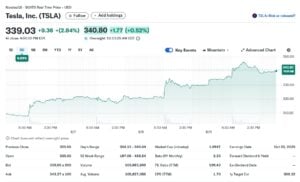
While the vision is ambitious, Tesla’s autonomous program hasn’t been without criticism. Early trial data in Austin shows around one notable system failure per vehicle every 2–8 days, equivalent to roughly 0.314 failures per day per car.
Videos posted online have captured incidents of Tesla’s robotaxis running stop signs, drifting into the wrong lanes, and failing to detect oncoming trains. The BBC highlighted that these issues have caught the attention of NHTSA, which confirmed it is in contact with Tesla to gather more information.
Early Performance and Safety Concerns
The NHTSA investigation adds to growing regulatory pressure. Reports suggest that Tesla has withheld certain incident data from public release, raising concerns about transparency in its robotaxi program.
Tesla’s self-driving systems face mounting scrutiny as new crash data raises safety concerns.
-
51 deaths since October 2024, including 2 linked to Full Self-Driving
-
Highest US crash rate in 2024: 26.67 accidents per 1,000 drivers — up 13.3% from 2023
-
Autopilot safety gap: 1 crash every 7.44 million miles on Autopilot vs. every 1.51 million miles without, as per Tesla’s Q1 2025 Vehicle Safety Report.
Statistically, Tesla currently has the highest crash rate of any U.S. automaker in 2024. Critics point out that while Musk often cites safety metrics favorable to Tesla, independent experts argue the data lacks consistent, third-party validation.
Musk’s Optimism vs. Robotaxi Reality
Elon Musk describes himself as “pathologically optimistic”, and his track record of bold promises supports that claim. Predicting that Tesla could cover half of the U.S. with robotaxi services within months is no small statement.
For now, Tesla’s Texas permit officially marks its entry into the state’s ride-hailing market. It puts the company in direct competition with Waymo, and brings Musk’s vision of a driverless future closer to reality.

However, Tesla still faces challenges. Experts are saying that it must improve safety, address regulatory concerns, and convince riders that its vision-only self-driving is as safe or safer than competitors using more sensors.
If Tesla succeeds, Texas could become the launchpad for a nationwide rollout, changing urban transportation and ride-hailing economics.
The post Tesla Robotaxi Secures Permit in Texas, Fuels TSLA Stock Surge and Market Buzz appeared first on Carbon Credits.
Carbon Footprint
BBVA Hits €30 Billion in Q2 for Sustainable Finance
Spanish banking firm Banco Bilbao Vizcaya Argentaria, aka BBVA, has set a new pace in sustainable finance. The bank recently announced that it has mobilized €30 billion ($32.5 billion) in green and social projects in Q2 2025 — its highest quarterly result ever. This brought its total for the first half of the year to €63 billion ($68.5 billion), marking a sharp 48% jump from the same period in 2024.
From Climate Action to Social Impact: BBVA’s €63 Billion Green Push
The growth pushes BBVA closer to its new target: channeling €700 billion ($760 billion) into sustainable financing between 2025 and 2029. The bank had already met its earlier €300 billion goal for 2018–2025 a year ahead of schedule, hitting the milestone in December 2024.
Of the €63 billion mobilized in H1 2025, 76% went toward climate change and natural capital projects. These covered areas such as renewable energy, efficient water use, sustainable agriculture, biodiversity protection, and the circular economy.
The remaining 24% went to social projects, including infrastructure for education and healthcare, entrepreneurship support, funding for small businesses, and financial inclusion for underserved communities.
Record Growth Across Business Segments
BBVA’s momentum came from strong growth in all business lines:
-
Commercial Banking: Mobilized €23.6 billion, up 53% year-on-year. Natural capital financing totaled €2.34 billion, with Mexico’s agricultural sector contributing half of that.
-
Corporate and Investment Banking (CIB): Contributed €31.9 billion, up 34%. The bank financed clean technologies, renewable projects, and sustainable supply chain solutions such as reverse factoring with green criteria. Renewable energy project funding alone reached €1.6 billion.
-
Retail Banking: Channeled €7.5 billion, up 119%. This included €742 million for hybrid and electric vehicle financing and digital tools that help customers measure potential energy savings.
Backing Breakthrough Clean Energy Projects
BBVA’s sustainability push isn’t just about volume — it’s also about innovation. In Q2 2025, the bank sponsored the Energy Tech Summit in Bilbao, attracting over 1,500 cleantech experts from 40+ countries.
There, it announced a landmark project finance deal — the first in the Iberian Peninsula for a hydrogen plant powered entirely by renewable energy. Scheduled to begin operations in H1 2026, the plant will be a key step in decarbonizing heavy industry.
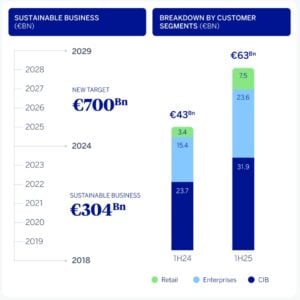
A More Ambitious €700 Billion Target
BBVA’s expanded goal more than doubles its previous plan, with a shorter deadline. The aim is to channel €700 billion in sustainable finance from 2025 to 2029, compared to the earlier €300 billion over eight years.
The strategy focuses on three pillars:
-
Climate Action – Funding renewable energy, clean technologies, and emissions reduction.
-
Natural Capital – Supporting agriculture, water conservation, biodiversity, and land restoration.
-
Social Opportunities – Financing healthcare, education, affordable housing, and entrepreneurship.
Driving the Net Zero Transition
Alongside its financing efforts, BBVA is working toward Net Zero emissions by 2050. It has already set interim 2030 decarbonization targets for ten sectors, including oil and gas, power generation, automotive, steel, cement, coal, aviation, shipping, aluminum, and real estate.
The bank is now preparing sector targets for agriculture — a major source of global emissions — as part of its broader climate plan.
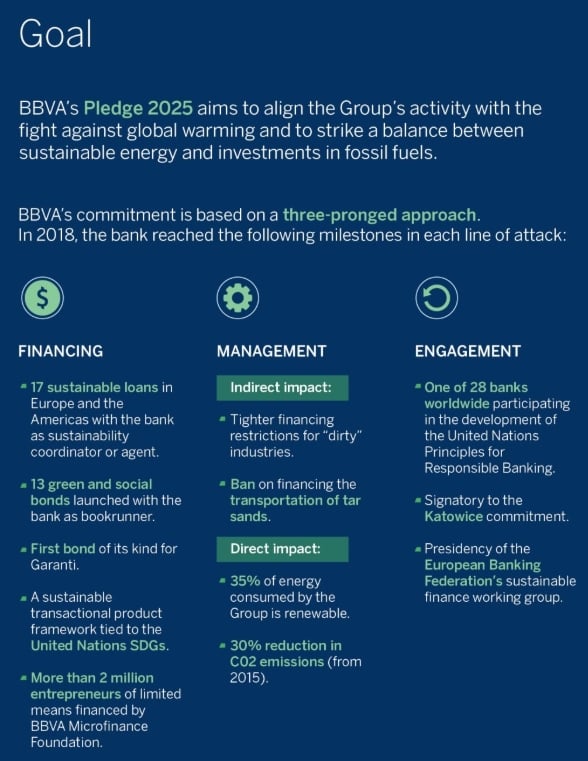
Why This €30 Billion Surge Matters
BBVA’s record-breaking quarter shows that sustainable finance is moving into the mainstream. The bank’s retail segment — up 119% — proves that demand for eco-friendly banking isn’t limited to corporations. Everyday, customers are increasingly choosing green loans, energy-saving solutions, and sustainable investment options.
These projects deliver dual benefits: reducing carbon footprints while improving social well-being. From renewable power plants to inclusive financing for small businesses, BBVA is aligning its growth with global sustainability goals.
How BBVA Plans to Hit the €700 Billion Mark
The bank’s roadmap includes expanding partnerships, scaling retail offerings, and enhancing digital sustainability tools. These platforms help clients understand the environmental impact of their investments, building transparency and trust.
For example, customers can estimate energy savings from home upgrades or track CO2 reductions from EV financing. By merging finance with real-time environmental insights, BBVA is turning sustainability into an accessible, measurable choice for more people.
Environmental and Carbon Benefits of These Investments
With 76% of funding directed to environmental projects in H1 2025, BBVA is investing heavily in emissions reduction, renewable energy, and ecosystem restoration.
Key highlights include:
-
Hydrogen & Renewables – €1.6 billion for renewable power and financing Iberia’s first renewable hydrogen plant.
-
Natural Capital – €2.34 billion for water conservation, sustainable agriculture, and biodiversity protection.
-
EV Transition – €742 million in hybrid and electric vehicle loans, cutting transport-related CO2.
These initiatives help replace fossil fuels, store carbon in healthier ecosystems, and encourage sustainable consumer behavior.
The Global Trend Fueling BBVA’s Growth
BBVA’s performance mirrors a global boom in sustainable finance. Green bond issuance could surpass €1 trillion annually by the end of 2025. Over 70% of large corporations now follow ESG strategies, driven by customer demand and regulatory pressure.
By beating its 2018–2025 target ahead of schedule and setting a new, more ambitious goal, BBVA is positioning itself among the leaders in climate-aligned banking. Its mix of green and social investments also supports the UN Sustainable Development Goals (SDGs).
Notably, its sustainability push comes with solid financial backing. The bank reported €5.45 billion in profit for H1 2025 and maintains strong capital reserves. Its “capital-light” growth model balances risk and return, keeping investors confident while pursuing long-term environmental impact.
What’s Next for Banking and Sustainability
The rise of ESG investing signals a shift in the role of banks. Customers, investors, and governments now expect institutions to be active players in the climate transition. BBVA’s quick pivot demonstrates its readiness to meet this demand at scale.
Going forward, expect more banks to adopt:
-
Clear Targets – Time-bound climate and social finance goals.
-
Transparency Tools – Digital platforms that track impact.
-
Innovation Financing – Support for emerging decarbonization technologies.
BBVA’s Role in Shaping the Future
From clean hydrogen plants to small business inclusion programs, BBVA’s sustainable finance strategy blends profitability with purpose. The bank is proving that climate action and social impact can be growth drivers, not just compliance measures.
Its combination of technology, strong performance, and measurable impact makes it a leader in the green banking race. As industries decarbonize and regulations tighten, banks that move early, like BBVA, will set the standard for the financial sector’s role in building a sustainable future.
The post BBVA Hits €30 Billion in Q2 for Sustainable Finance appeared first on Carbon Credits.
Carbon Footprint
Meta’s AI Forest Map: The Game-Changer for Carbon Tracking
Forests are vital for our planet. They help fight climate change by absorbing a lot of carbon dioxide from the air, acting as major carbon sinks. They store large amounts of carbon in biomass and soil, estimated to absorb about 30% of human-caused CO2 emissions annually worldwide.
However, scientists and project managers must track forest health. They need to know how much carbon forests store. This helps ensure that efforts to protect or grow forests are effective. This is called measuring, monitoring, reporting, and verifying forest carbon, often shortened to MMRV.
Eyes in the Sky: How Remote Sensing Sees Forests Differently
Measuring carbon in forests is tricky and expensive. Usually, people go out into the forest and measure trees by hand, which takes a lot of time and effort. It’s hard to do this over large areas, especially in dense or remote forests.
This is where remote sensing comes in.
Remote sensing is a way to gather information about forests without going there in person. It uses satellites, airplanes, or drones equipped with cameras and sensors. This technology can take pictures and collect data. It helps scientists learn how tall trees are, how dense the forest is, and how much carbon it might store.
There are different kinds of remote sensing data:
- Optical imagery: like normal photos taken from space or planes, showing the tops of trees and land features.
- Radar: which uses radio waves and can see through clouds and work at night.
- Lidar: which uses lasers to map the exact height and shape of trees in 3D.
The Challenge with Remote Sensing Data
Each data type has strengths and weaknesses. Optical images are good and widely available, but they can’t see through clouds and only show forest surfaces. Radar can see through clouds but has trouble measuring details in dense forests. Lidar is very accurate but expensive and covers less area.
To get the best info, scientists combine different types of data using artificial intelligence (AI) and machine learning techniques. Machine learning helps computers find patterns in huge amounts of data to make better estimates.
Meta’s Canopy Height Map: AI-Powered Forest Intelligence
Meta developed a unique AI model that merges high-resolution satellite images with lidar data. This model maps tree canopy heights globally with great detail—less than one meter per pixel. This means it can see individual trees in many places.
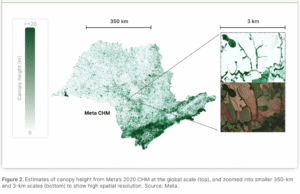
The map and the AI model are open-source and freely available, so anyone can use them to help forest projects. They enable better planning, monitoring, and verification of forest carbon projects. Reza Rastegar, Senior Manager of Research Science at Meta, stated:
“When applied thoughtfully, we believe AI research and remote-sensing tools, particularly those that are open source, have the potential to revolutionize the transparency and accessibility of the carbon market.”
Meta’s model has been validated with mean absolute errors of 2.8 meters in U.S. forests and 5.1 meters in Brazil. This reflects a promising improvement in estimating canopy height at fine scales. These advanced datasets and models are helping to track natural regeneration, selective logging, and forest degradation more accurately, which is vital for credible MMRV of carbon credits.
What’s special about this model?
- It works globally with very fine detail.
- It can help identify important areas to protect or restore.
- It can make new maps for different times if good images are available.
- It helps detect small changes in forests, like selective logging (cutting some trees but not all).
- It supports methods from carbon credit standards. This is important for those who need dynamic baselining or updating project baselines with real data from nature.
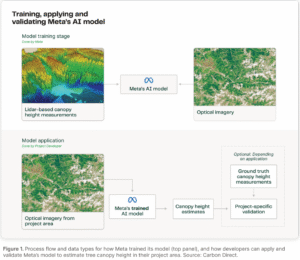
RELATED: Meta and Microsoft Secured Long-Term Carbon Credit Deals to Support Olympic Rainforest
From Pixels to Carbon Credits: Turning Data into Climate Action
Forest carbon projects use different official methods to create and verify forest carbon credits. The three main methods Meta focuses on are:
- Verra VM0045 – for improved forest management (IFM).
- Verra VM0047 – for afforestation, reforestation, and revegetation (ARR).
- American Carbon Registry (ACR) IFM – a US-based improved forest management method.
Here’s how Meta’s canopy height map and AI model fit into these methods:
- In project planning, the map helps find good parcels of forest to include, determine project boundaries, and understand forest structure.
- For dynamic baselining, especially in ARR and ACR’s IFM methods, the AI model can help update baselines based on real forest growth or loss over time.
- For reversals monitoring (tracking if carbon gains are lost, e.g., due to fire or logging), the map gives better details to detect forest disturbances.
The Fine Print: What Meta’s Model Gets Right—and Where It Struggles
Many traditional satellite products can’t reliably measure forest height or biomass in dense forests or small areas. Meta’s model, because it uses very high-resolution images, helps overcome this.
Monitoring small or fragmented forests, river corridors, or areas with selective logging is crucial. These places are difficult to track using low-resolution data.
Meta’s canopy height model is a powerful tool for estimating forest structure, but it comes with limitations. It works best with high-quality imagery at 0.5–1 meter resolution. The global canopy height map uses images from 2009 to 2020. This means it might not show current forest conditions. So, there’s a need for updated maps.
Accuracy may also drop in underrepresented forest types, so local validation with field or lidar data is advised. Using the model requires significant computing power and technical expertise, which may limit adoption.
For forest carbon projects, remote sensing offers great promise but faces barriers. There is no universal agreement among registries, buyers, and developers on acceptable methods or datasets.
In addition, technical skills, computational capacity, and access to affordable, high-quality datasets remain limited. Uncertainty around accuracy—and lack of consensus on acceptable error levels—make trust and comparability difficult.
For the identified barriers, the report authors recommend the following:
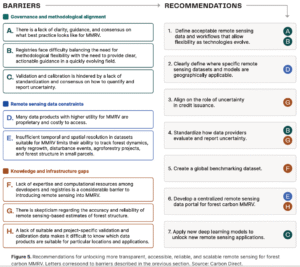
Closing the Gap Between Innovation and Impact
Experts want clearer standards for how datasets can be used. They also seek better reporting on uncertainty and clearer rules for issuing carbon credits. A global benchmarking database with verified data and a central portal for quality datasets could help boost adoption.
Moreover, easier AI tools would make this process smoother. Integrating advanced models like Meta’s into accessible platforms, alongside collaborative standard-setting, will be crucial to scaling reliable forest carbon monitoring and verification.
Examples of New and Exciting Uses of Meta’s Model
- Counting trees in agroforestry projects to monitor performance.
- Mapping old-growth forests and biodiversity hotspots.
- Detecting subtle forest degradation, like selective logging.
- Monitoring reversals (losses of carbon stored) with greater accuracy.
- Supporting more accurate estimates of above-ground biomass.
Forests are vital to fighting climate change by storing carbon, but measuring how much carbon they hold and how this changes over time is tough. New technologies like remote sensing are making this easier, faster, and cheaper.
Meta’s AI-powered canopy height map is a cutting-edge tool offering very detailed, global forest height data that can help in planning, monitoring, and verifying forest carbon projects.
The post Meta’s AI Forest Map: The Game-Changer for Carbon Tracking appeared first on Carbon Credits.
-
Climate Change2 years ago
Spanish-language misinformation on renewable energy spreads online, report shows
-
Climate Change Videos2 years ago
The toxic gas flares fuelling Nigeria’s climate change – BBC News
-

 Greenhouse Gases1 year ago
Greenhouse Gases1 year ago嘉宾来稿:满足中国增长的用电需求 光伏加储能“比新建煤电更实惠”
-

 Climate Change1 year ago
Climate Change1 year ago嘉宾来稿:满足中国增长的用电需求 光伏加储能“比新建煤电更实惠”
-

 Carbon Footprint1 year ago
Carbon Footprint1 year agoUS SEC’s Climate Disclosure Rules Spur Renewed Interest in Carbon Credits
-
Climate Change2 years ago
Why airlines are perfect targets for anti-greenwashing legal action
-
Climate Change Videos2 years ago
The toxic gas flares fuelling Nigeria’s climate change – BBC News
-
Climate Change2 years ago
Some firms unaware of England’s new single-use plastic ban




